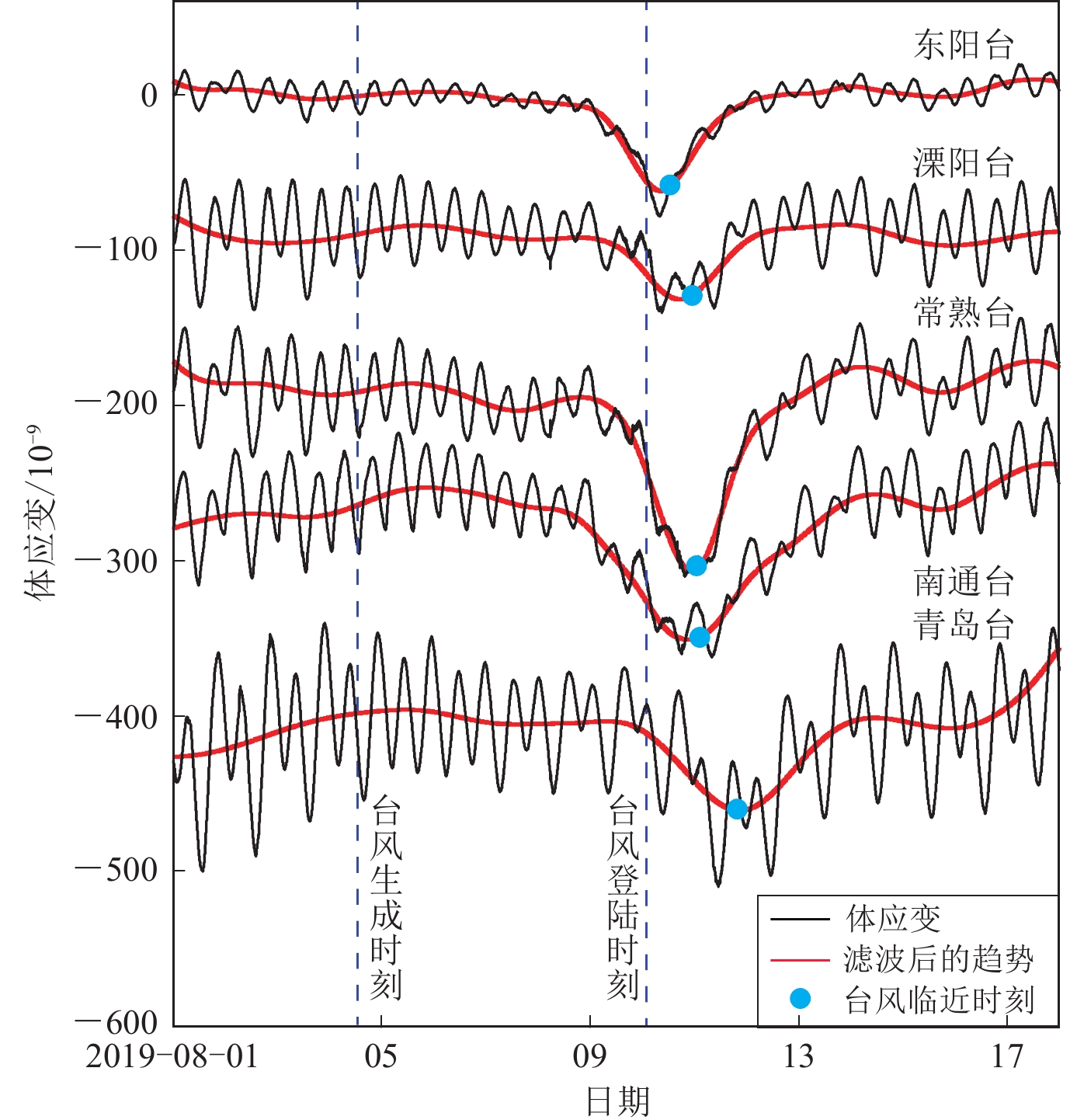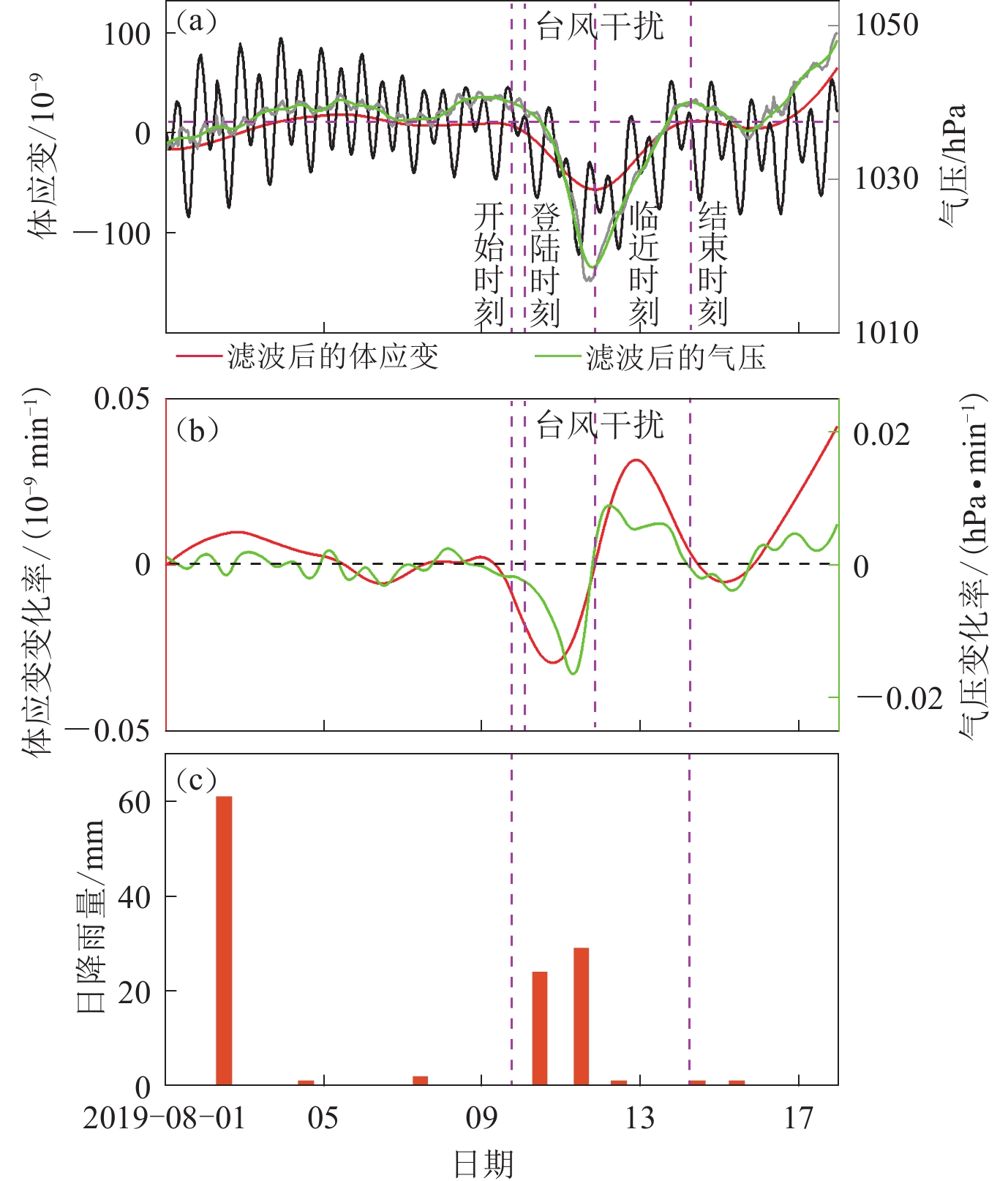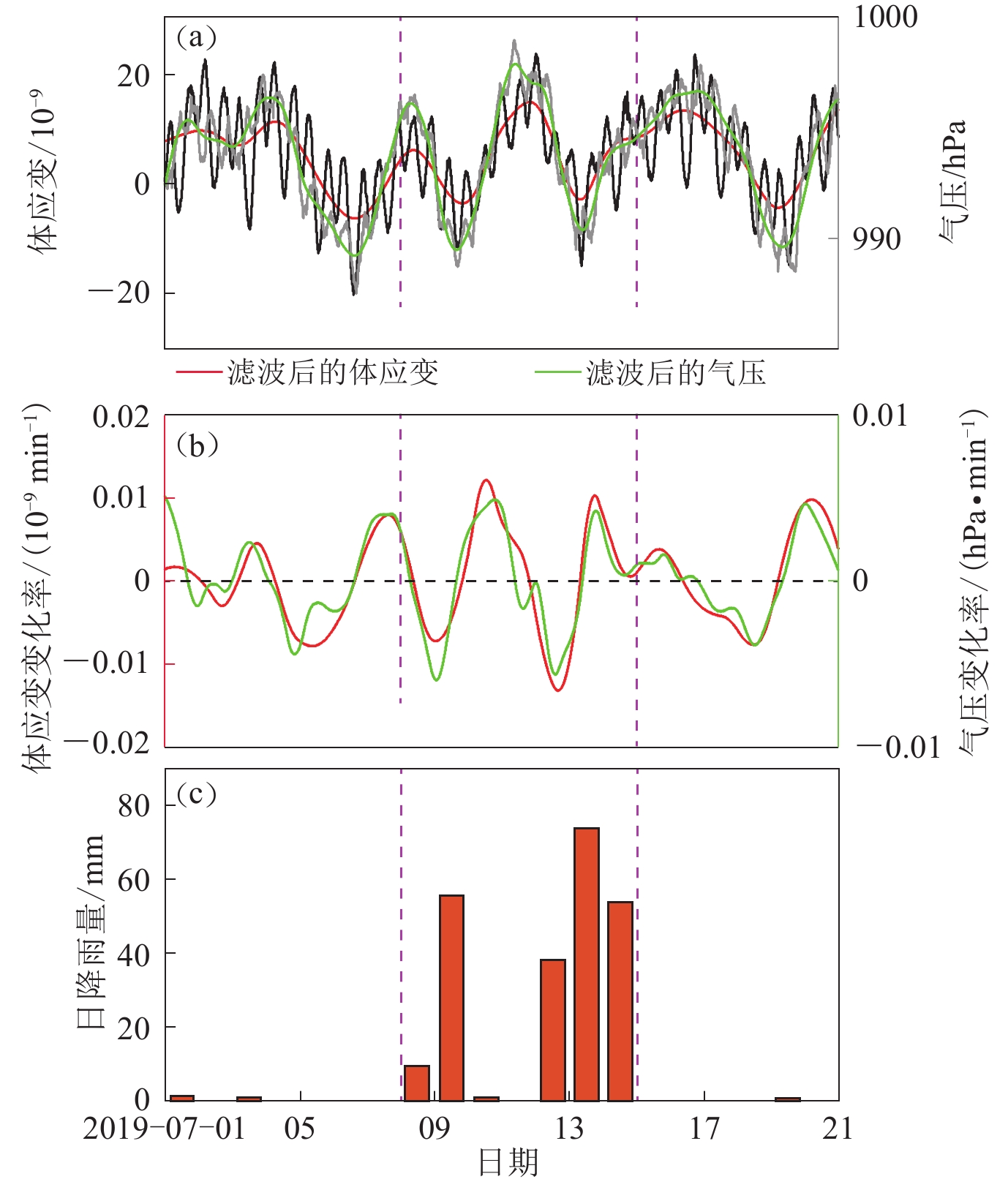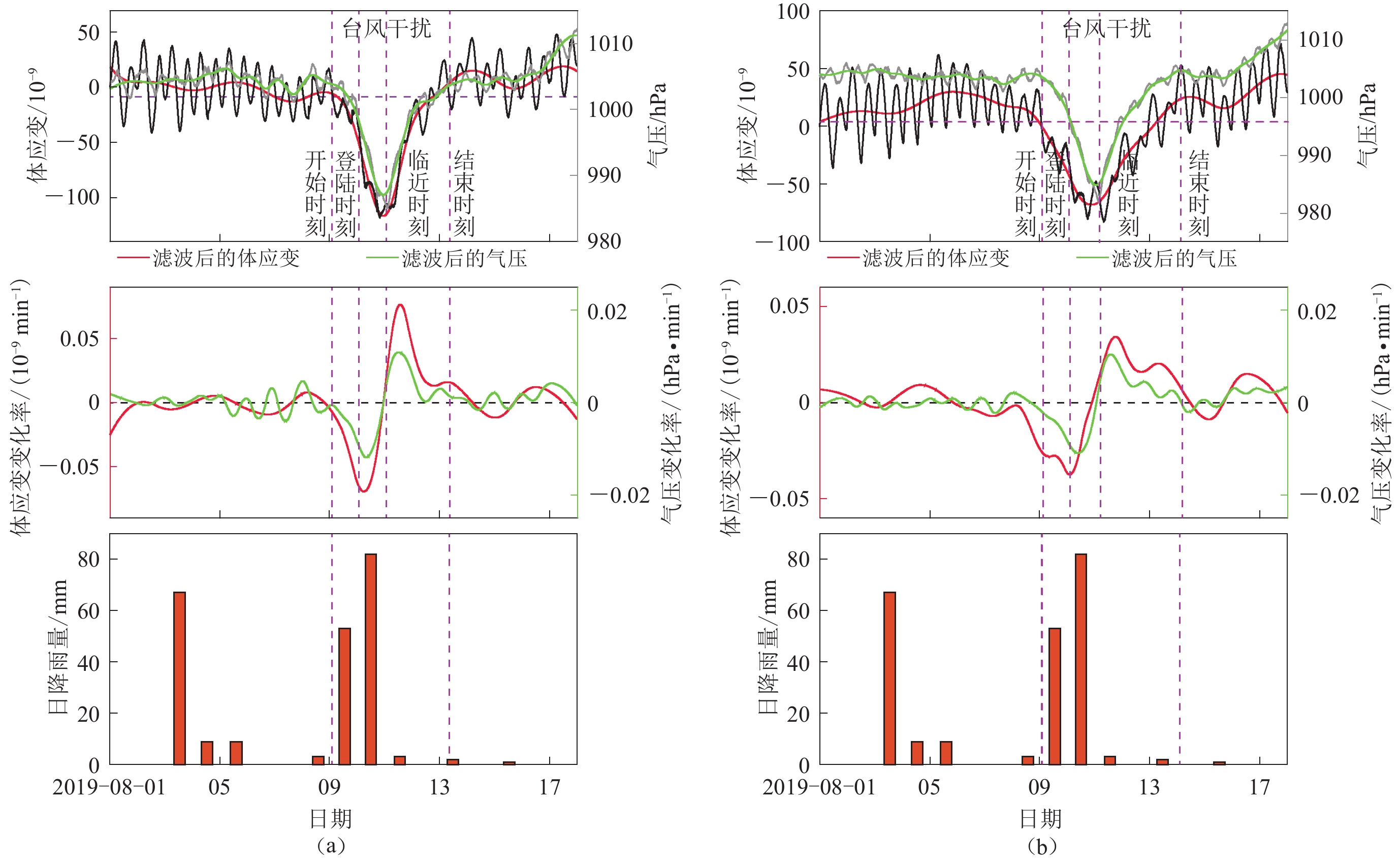Signature and physical mechanism of borehole dilatometers in response to super typhoon Lekima in southeastern coastal area of China
-
摘要: 依据超强台风 “利奇马” 的强度和时空演变特征,本文采用经验模态分解等方法系统地分析并揭示了该台风对我国东南沿海地区钻孔体应变影响的全貌,并在此基础上对台风扰动的机制进行了初步探讨。结果表明:① 台风演变过程中漏斗状的长周期气压波动,是造成钻孔体应变大幅张性变化的物理成因,且体应变对台风低压系统具有即时的线弹性响应特征,其变化形态与气压漏斗高度相似,弹性变形的持续时间与气压波动的历时较一致;② 在周期为103 h时,−18.2 hPa的气压变幅便可在地下62 m深处产生高达−112.1×10−9的体应变,该频点的气压影响系数为6.2×10−9/hPa;③ 在空间上,台风中心在980 km以外便能影响体应变观测,且随着台风的不断逼近或远离,其影响程度也相应地逐渐增强或减弱。
-
关键词:
- 超强台风 “利奇马” /
- 钻孔体应变 /
- 东南沿海 /
- 气压负荷 /
- 台风暴雨
Abstract: The aim of this study is to investigate how volumetric strain and super typhoon Lekima interact with each other. By combining the intensity and spatio-temporal evolution of Lekima, we systematically analyze the extracted volumetric deformation of shallow crust at five stations in the southeastern coastal area of China induced by Lekima using a decomposition analysis called the empirical mode decomposition (EMD). Furthermore, we discuss the physical mechanism of typhoon-induced volumetric strain. The results show that: ① The super typhoon’s signature consists in a ground dilatation due to barometric pressure drop drastically, generally followed by a ground compression due to the barometric pressure recovery. The dynamic patterns for the volumetric strain and the barometric pressure are both similar to the symme-trical funnel, and the response of volumetric strain to the barometric pressure is almost instant and linear. In addition, the durations are nearly equivalent for both of them. ② The maximum magnitude in volumetric strain induced by barometric pressure with fluctuation of −18.2 hPa can reach up to −112.1×10−9 in the 62 m deep borehole, and the corresponding coefficient of barometric pressure response is about 6.2×10−9/hPa at the 103-hour period. ③ Obviously, the dilatometer records can be remotely disturbed by super typhoon at a distance of approximately 980 km away from the borehole site. When the typhoon center approaches or moves away from the borehole site, the dilatational magnitude of borehole strain will increase or decrease correspondingly. The obtained results can be used not only for identifying and determining reasonably the physical mechanism of anomalous changes induced by typhoon in low-frequency range for southeastern coastal and inland areas in China, but also for contributing the reliably observational evidences to the theoretical model research for the volumetric strain in response to barometric pressure in the low-frequency range. -
引言
钻孔体应变仪自1968年被成功研制以来(Sacks et al,1971;Evertson,1977),由于其高灵敏度(优于10−9)和甚宽频带(零到数十Hz)等突出优点,便为探赜地震前兆、震源过程、断层滑动、构造运动和火山喷发等动力学机制提供了新视角(Sacks et al,1978;Linde et al,1996;Roeloffs,2006;张凌空,牛安福,2008;邱泽华等,2012;Takanami et al,2013;Bonaccorso et al,2016;邱泽华,2017;Barbour,Crowell,2017)。在近半个世纪的观测与探索过程中,其重要的理论价值和巨大的应用潜力已渐露峥嵘。
但不足之处是钻孔体应变仪的观测深度普遍较浅(300 m以内),气象和水文等非构造因素会在更宽频率范围内对观测值产生较显著的干扰(Asai et al,2009),这不仅不利于孕震、断层活动和构造运动等弱信号的合理提取,还增加了非构造信号识别与改正的复杂度。相比内陆,沿海地区的钻孔体应变测点更易受到台风的强干扰(Mouyen et al,2017)。强度高且尺度大的台风通过低气压和暴雨即可造成地壳体应变的显著变化。从日本南关东地区的观测实例来看,台风天气系统下的气压影响系数高达20.4×10−9/hPa (檜皮久義等,1983);加之,此类体应变的信号特征与慢地震非常相似,所以极易被误判(Liu et al,2009;Hsu et al,2015;Mouyen et al,2017)。因此,系统地诊断台风对钻孔体应变观测的干扰特征及影响量,对科学推定近地表的弹性结构、台风负荷所产生的地壳应力场以及探讨能否由此触发慢地震等极为关键。而这些科学问题,也日益成为地震预测和地壳动力学研究中的热点和难点。
近年来,许多研究人员已采用回归分析、数字信号处理和理论模型等方法,对上述问题展开了深入研究。檜皮久義等(1983)通过线性回归分析了台风过境日本东海和南关东地区期间的气压梯度与31个钻孔体应变测点响应量的关系,由此实测出长周期(近3天)气压波的影响系数。袁媛等(2017)则利用小波分解方法分析了台风 “浣熊” 和 “海葵” 对佘山台分量钻孔应变的扰动特征,结果显示2—16分钟频段内的应变幅值均呈上升—下降的规律,且与台风中心到台站之间距离的相关性较好,并进一步揭示出其动力可能源自台风所激发的近岸长重力波。对于台风期间气压波动所产生的理论体应变场,可由地表气压的弹性负荷模型进行解算,但该方法需要精确测得台风常数r0和气压场的分布特征(陈孔沫,1981;上垣内修,1987)。而对于长周期气压波(周期 T≥12 h),其气压影响系数仅与围岩的弹性模量和泊松比相关(Hsu et al,2015;张凌空,牛安福,2019),所以,Hsu等(2015)将台风的气压负荷更进一步简化为单轴应力或应变问题,由此可有效推定测点处体应变的理论响应量。对于台风暴雨的影响,则可通过布辛尼斯克(Boussinesq)公式、状态-空间模型(state-space model)和水箱模型(tank model)定量地计算(Peng et al,2014;木村一洋等,2015),尽管这些模型给出的结果略有差异,但总体来看,降水量与钻孔体应变的压性响应量大致呈线性关系(Hsu et al,2015)。
在全球变暖的背景下,西北太平洋成为了世界上热带气旋最活跃的海域,平均每年生成的热带气旋有20多个,约占全球的1/3 (Matsuura et al,2003)。我国濒临西北太平洋,加之东南沿海区域地表温度偏高,平均每年约有8个台风登陆,所以我国是世界上少数遭受台风影响最严重的国家之一(Wu et al,2005;袁金南等,2008;Peduzzi et al,2012;Xu et al,2013)。这样的极端灾害性天气,也成为我国东南沿海地区钻孔体应变观测的一大气象干扰源。但台风所产生的长周期气压波动及强降水,对我国近岸钻孔体应变的影响特征及机制究竟如何?截至目前,相关研究还尚少。2019年发生的1909号超强台风 “利奇马” ,是1949年以来登陆中国的第五大强台风,而且其陆上强度维持在热带风暴及以上级别的时长高达44小时,陆上滞留时长位列第六。如此典型而罕见的超强台风,其研究价值颇高;加之,我国东南沿海地区的5个响应较显著的钻孔体应变台站,距 “利奇马” 中心路径的最小间距均小于90 km,这也有利于捕捉高信噪比的台风扰动信号。为此,本文拟将这些台站作为个例加以研究,旨在深刻揭示我国东南沿海地区钻孔体应变对台风演变过程响应的特征及其物理机制,以期为我国沿海甚至内陆地区台风干扰的有效识别和合理量化等提供参考依据。
1. 台风和台站概况
1.1 “利奇马” 演变实况
超强台风 “利奇马” 的最佳路径、中心最低气压和强度等级等信息均源自中央气象台台风网(2019),时间分辨率分别为1 h (2019年8月10日02时至11日08时,北京时)和3 h (2019年8月4日14时至10日02时,2019年8月11日08时至13日11时,北京时)。2019年8月4日14时,1909号超强台风 “利奇马” 于菲律宾吕宋岛以东的西北太平洋洋面生成,继而沿西北偏北方向移动发展;在7日23时升格为超强台风,此时其中心最低气压为930 hPa,移动速度达到20 km/h;10日01时45分左右以超强台风等级在浙江省温岭市登陆,登陆时中心最低气压为930 hPa,移动速度为18 km/h;登陆后强度逐渐减弱,11时台风中心逼近至东阳台35 km处,此时台风已减弱为强热带风暴,中心最低气压为975 hPa,移动速度为15 km/h,并于22时移出浙江;之后,北翘行进,途经江苏和山东,于12日05时移入渤海,最终于13日11时衰减为热带低压并停止编号。 “利奇马” 的生命史共9天,其具体的移动路径和强度演变过程详见图1。总体而言,该台风具有登陆强度大、陆上衰减慢、路径复杂和生命史长等四大特点。
![]() 图 1 超强台风 “利奇马” 的最佳路径和强度演变及东南沿海地区钻孔体应变台和气象站位置Figure 1. The best track and intensity (colored circles) of super typhoon Lekima (from 14:00 BJT on 4 August 2019 to 11:00 BJT on 13 August 2019,equally spaced at 1 h or 3 h,respectively) marked with time as well as locations of borehole dilatometer stations (black triangles)and meteorological stations (green triangles) in southeastern coastal area of China
图 1 超强台风 “利奇马” 的最佳路径和强度演变及东南沿海地区钻孔体应变台和气象站位置Figure 1. The best track and intensity (colored circles) of super typhoon Lekima (from 14:00 BJT on 4 August 2019 to 11:00 BJT on 13 August 2019,equally spaced at 1 h or 3 h,respectively) marked with time as well as locations of borehole dilatometer stations (black triangles)and meteorological stations (green triangles) in southeastern coastal area of China1.2 钻孔体应变台站概况
“利奇马” 过境我国东南沿海地区期间,响应较显著的钻孔体应变台站主要有东阳、溧阳、常熟、南通和青岛等5个测站。以上台站所安装的钻孔体应变仪皆为TJ-2型,该型仪器是由我国自主研制并达到了世界先进水平的体积式应变仪,其采样率为1次/min,分辨率优于10−9 (苏恺之等,2002)。另外,考虑到各台站钻孔水位仪和雨量计运行较不稳定,观测数据不太准确,本文选用了距各台站较近的杭州、上海和青岛等3个国际气象交换站的降水数据(NOAA,2019),其中,杭州气象站与台风路径的最小间距仅约3 km,因此能较客观地反映台风强盛时段其内螺旋雨带的暴雨强度(图1)。各台站及其相邻地面气象站的详细信息参见表1,从中可以看出,南通台的钻孔深度最深,为94 m,其它各台均在60 m左右。
表 1 5个钻孔体应变台站及其周邻地面气象站的概况Table 1. General information for the five borehole dilatometer sites and three neighboring meteorological stations台站 钻孔深度/m 钻孔围岩岩性 距海岸线距离/km 邻近的气象站 距气象站距离/km 东阳 67 泥质粉砂岩 120 杭州 110 溧阳 60 安山岩 240 杭州 140 常熟 62 石英砂岩 110 上海 80 南通 94 石英砂岩 50 上海 85 青岛 56 花岗岩 0.2 青岛 6 2. “利奇马” 的干扰特征及影响因子分析
2.1 东南沿海地区钻孔体应变响应的时空特征
在 “利奇马” 演变期间,表1所列的5个钻孔体应变台站都较好地记录到此次超强台风的扰动过程(图1,2)。从已有的研究(周龙寿,邱泽华,2008;邱泽华,2017)来看,钻孔体应变对气压具有频响特性,且低频(周期T>2 000 s)气压对其影响更为显著。所以,为了客观地呈现台风期间低频(T>24 h)体应变的变化特征,本文首先对体应变的原始观测数据进行预处理,主要目的是去线性趋势和去均值。之后,采用适于非平稳非线性信号的经验模态分解方法(empirical mode decompo-sition,缩写为EMD)(Huang et al,1998),以滤除预处理数据中周期T≤24 h的信号,主要包括大气潮、体潮和海潮等日波和半日波成分。图2中的红色曲线即为各台站滤波后的结果。
![]() 图 2 5个钻孔体应变台记录的 “利奇马” 低频扰动曲线Figure 2. The low-frequency signatures of super typhoon Lekima recorded by the borehole dilatometers at five stations during 1−17 August 2019Time series after linear curves are removed from the original one-minute-sampled volumetric strain data (black lines),and red lines show the trends of long-period changes in volumetric strain. The vertical left and right dashed lines mark the timing of Lekima's initiation and first landfall,respectively. The blue circle indicates the time when the typhoon was the nearest to the borehole dilatometer station.
图 2 5个钻孔体应变台记录的 “利奇马” 低频扰动曲线Figure 2. The low-frequency signatures of super typhoon Lekima recorded by the borehole dilatometers at five stations during 1−17 August 2019Time series after linear curves are removed from the original one-minute-sampled volumetric strain data (black lines),and red lines show the trends of long-period changes in volumetric strain. The vertical left and right dashed lines mark the timing of Lekima's initiation and first landfall,respectively. The blue circle indicates the time when the typhoon was the nearest to the borehole dilatometer station.结合图1和图2,可以清楚地看出各台站在低频段对 “利奇马” 的响应全貌。就变化形态而言,各台站张性变形的强度均随 “利奇马” 中心位置呈急剧降升的对称漏斗状变化特征。当其中心位置距各台站最近时,体应变达到谷值,这说明随着 “利奇马” 的不断逼近或远离,各台站体应变张性变化的幅度相应地线性增大或减小。此外,各台站体应变谷值出现的时间次序,也与 “利奇马” 过境各台站的时刻相一致。在变化强度上,溧阳台的应变谷值最小,常熟台则最大,分别约为−37×10−9和−112×10−9。虽然 “利奇马” 在过境常熟台时,强度已降格为热带风暴,但该台站的响应幅度却明显大于其它台站,这可能是由于该台站钻孔深度较浅,且钻孔围岩为强度较低的石英砂岩等因素所致(彭剑文等,2017)。在下一节中,本文将深入分析各台站对 “利奇马” 响应的动力机制。
总体而言,各台站钻孔体应变的响应特征与台风中心的位置密切相关,这也揭示出 “利奇马” 能导致其过境区域近地表出现显著且即时的线弹性变形。
2.2 钻孔体应变台站对 “利奇马” 的响应特征
为了更好地与台风中心的最低气压进行对比,本文仅去除气压观测数据的线性趋势,并保留其均值;之后,对体应变和气压趋势进行一阶求导,以获取二者的动态变化率,其主要作用在于准确地确定台风影响的开始和结束时刻。需要说明的是,本文的主要目的是探讨台风引起的低频钻孔体应变(周期T>24 h),所以暂不对相对高频的扰动信号予以分析。
图3—5分别为2019年8月8—14日期间各台站钻孔体应变仪、气压计和雨量计观测到的超强台风过程。经过前述的信号处理之后,可以清楚地看到各台站体应变响应的全过程,即随着 “利奇马” 不断逼近和远离,钻孔体应变和气压均呈现对称的漏斗状形态,二者形态高度相似,且长周期变化特征非常显著。以东阳台为例(图3a),随着 “利奇马” 不断逼近,气压和钻孔体应变均在8月8日17时左右开始快速下降;在台风登陆时刻,二者变化量分别达−16.8 hPa和−43.5×10−9,并于10日11时达到谷值,数值分别为971.1 hPa和−60.7×10−9,相应最大变化量分别为−20.1 hPa和−52.8×10−9,此时该台站距台风中心仅35 km;此后,随着台风逐渐远离,二者在12日10时恢复至正常变化,整个响应过程持时约89 h。期间,气压和体应变变化率的范围分别为−0.016—0.014 hPa/min和−0.040×10−9—0.038×10−9/min(图3a)。而在空间上,可以看到该台站对 “利奇马” 开始、登陆、临近和结束响应的距离依次为770,150,35和900 km (图1)。
![]() 图 3 东阳台(a)、溧阳台(b)和杭州气象站在 “利奇马” 过境期间的观测数据图中第一行为钻孔体应变和气压记录及趋势,第二行为钻孔体应变和气压的变化率,第三行为日降水量Figure 3. Records of the volumetric strain and barometric pressure at the stations Dongyang (a) and Liyang (b) as well as daily rainfall data at Hangzhou meteorological station under the passage of super typhoon Lekima during August 1−17,2019The upper panels show the traces of the volumetric strain (black) and barometric pressure (gray),where red and green lines show the trends,respectively;the middle panels represent the variation rates of the volumetric strain (red) and barometric pressure (green);the lower panels represent the daily rainfall
图 3 东阳台(a)、溧阳台(b)和杭州气象站在 “利奇马” 过境期间的观测数据图中第一行为钻孔体应变和气压记录及趋势,第二行为钻孔体应变和气压的变化率,第三行为日降水量Figure 3. Records of the volumetric strain and barometric pressure at the stations Dongyang (a) and Liyang (b) as well as daily rainfall data at Hangzhou meteorological station under the passage of super typhoon Lekima during August 1−17,2019The upper panels show the traces of the volumetric strain (black) and barometric pressure (gray),where red and green lines show the trends,respectively;the middle panels represent the variation rates of the volumetric strain (red) and barometric pressure (green);the lower panels represent the daily rainfall![]() 图 5 青岛台和青岛气象站在 “利奇马” 过境期间的观测数据(a) 钻孔体应变和气压记录及趋势;(b) 钻孔体应变和气压的变化率;(c) 日降水量Figure 5. Records of the volumetric strain and barometric pressure at Qingdao station and daily rainfall data at Qingdao meteorological station under the passage of super typhoon Lekima during August 1−17,2019(a) Traces of the volumetric strain (black) and barometric pressure (gray),red and green lines show the trends;(b) The variation rates of the volumetric strain (red) and barometric pressure (green);(c) The daily rainfall
图 5 青岛台和青岛气象站在 “利奇马” 过境期间的观测数据(a) 钻孔体应变和气压记录及趋势;(b) 钻孔体应变和气压的变化率;(c) 日降水量Figure 5. Records of the volumetric strain and barometric pressure at Qingdao station and daily rainfall data at Qingdao meteorological station under the passage of super typhoon Lekima during August 1−17,2019(a) Traces of the volumetric strain (black) and barometric pressure (gray),red and green lines show the trends;(b) The variation rates of the volumetric strain (red) and barometric pressure (green);(c) The daily rainfall2.3 钻孔体应变台站对 “利奇马” 响应的动力诊断
尽管各台站体应变与气压的变化形态高度相关,但二者是否具有物理关联仍需对台风扰动期间降雨因子的干扰进行分析。由于台风过境东阳台时的降雨量最大,所以,仍以东阳台为例。从图3a最下面一行可以看出,在8月9—12日台风强干扰期间,杭州气象站的逐日累计降水量虽然高达167 mm,但并未引起东阳台出现显著的压性体应变,这定性说明强降水负荷对该台站的影响较小。为了进一步验证该推测的可靠性,本文对非台风时段强降水对该台站的影响实况进行了回溯对比。
图6为2019年7月8—14日杭州气象站记录到的一次非台风天气所产生的强降水过程,累计降水量高达231.9 mm。从图6a中气压和体应变的趋势变化可以看出,在强降水期间二者的最大变化量分别为8.3 hPa和18.8×10−9,与之对应的周期约为3.8天和3.4天;再结合图6b,不难看出气压与体应变的相关性很好。此外,还可以发现在气压波动幅度较小而降水量较大的情况下,体应变并未出现显著的压缩变化。因此,从以上定性分析的结果来看,降水对东阳台体应变观测的影响较小。更进一步,对于半无限空间弹性介质模型,降水所产生的理论体应变可通过布辛尼斯克公式求解,计算公式为
![]() 图 6 非台风情况下强降水事件对东阳台观测数据的影响(a) 钻孔体应变和气压记录及趋势;(b) 钻孔体应变和气压的变化速率;(c) 日降水量Figure 6. Records of the volumetric strain and barometric pressure at Dongyang station and daily rainfall data at Hangzhou meteorological station under the heavy rainfall induced by non-typhoon weather during July 1−20,2019(a) Traces of the volumetric strain (black) and barometric pressure (gray),red and green lines show the trends;(b) The variation rates of the volumetric strain (red)and barometric pressure (green);(c) The daily rainfall
图 6 非台风情况下强降水事件对东阳台观测数据的影响(a) 钻孔体应变和气压记录及趋势;(b) 钻孔体应变和气压的变化速率;(c) 日降水量Figure 6. Records of the volumetric strain and barometric pressure at Dongyang station and daily rainfall data at Hangzhou meteorological station under the heavy rainfall induced by non-typhoon weather during July 1−20,2019(a) Traces of the volumetric strain (black) and barometric pressure (gray),red and green lines show the trends;(b) The variation rates of the volumetric strain (red)and barometric pressure (green);(c) The daily rainfall${\varepsilon _{\rm{v}} } {\text{=}} \frac{{2\!\!\!\!{\text{(}}1 {\text{+}} \nu {\text{)}}\!\!\!\!\!\!\!\!{\text{(}}1 {\text{-}} 2\nu{\text{)}}\!\!\!\!P}}{E}{\text{,}}$


(1) This page contains the following errors:
error on line 1 at column 1: Start tag expected, '<' not foundBelow is a rendering of the page up to the first error.
为何理论值与观测实况差异如此显著?究其原因,可能主要是由于东阳地区降水丰沛,多年平均降水量可达1 100—1 600 mm (梁溯安,2012),地表含水量相对较高。当出现短时强降水天气时,降水可能以径流的形式快速运移,其入渗量较为有限,所以台风暴雨在地表产生的负荷压力较小。
而溧阳、常熟、南通和青岛台,在台风扰动期间的日累计降水量依次为167,141,142和54 mm,其产生的理论体应变量可按照式(1)进行计算。依据表1所列各台站的台基岩性,E依次取40,10,15和50 GPa,泊松比ν均取典型值0.25,则降水负荷所产生的理论体应变量分别约为51.3×10−9,172.5×10−9,115.8×10−9和13.2×10−9。显然,青岛台的值较小,可大致忽略;其它台站相对较大,但这些台站并未观测到显著的压性变形(图3b,4),这说明上述量级的降水尚未超过其干扰的阈值。因此,可大致推定出台风扰动期间降水因子对各台站的干扰较小。
![]() 图 4 常熟台(a),南通台(b)和上海气象站在 “利奇马” 过境期间的观测数据图中第一行为钻孔体应变和气压记录及趋势,第二行为钻孔体应变和气压的变化率,第三行为日降水量Figure 4. Records of the volumetric strain and barometric pressure at the stations Changshu (a) and Nantong (b) as well as and daily rainfall data at Shanghai meteorological station under the passage of super typhoon Lekima during August 1−17,2019The upper panels show the traces of the volumetric strain (black) and barometric pressure (gray),where red and green lines show the trends,respectively;the middle panels represent the variation rates of the volumetric strain (red) and barometric pressure (green);the lower panels represent the daily rainfall
图 4 常熟台(a),南通台(b)和上海气象站在 “利奇马” 过境期间的观测数据图中第一行为钻孔体应变和气压记录及趋势,第二行为钻孔体应变和气压的变化率,第三行为日降水量Figure 4. Records of the volumetric strain and barometric pressure at the stations Changshu (a) and Nantong (b) as well as and daily rainfall data at Shanghai meteorological station under the passage of super typhoon Lekima during August 1−17,2019The upper panels show the traces of the volumetric strain (black) and barometric pressure (gray),where red and green lines show the trends,respectively;the middle panels represent the variation rates of the volumetric strain (red) and barometric pressure (green);the lower panels represent the daily rainfall综上所述, “利奇马” 演变过程中的低气压系统,是引起各台站体应变呈对称漏斗状形态的物理成因。
此外,本文全面统计了各台站对 “利奇马” 响应的具体过程和各参数幅值,相关结果详见表2,可以看出,在低频段(周期T>24 h), “利奇马” 对各台站的扰动距离、历时和幅值及气压影响系数等特征可归纳如下:① “利奇马” 在远离青岛台980 km时,便已影响青岛台的体应变观测,溧阳台、南通台和东阳台的扰动距离次之,常熟台则最小,为760 km;② 台风扰动的历时在89—120 h之间,其中,东阳台的扰动历时最小,但随着台风持续北上,其能量逐渐衰减,台风移速也相应降低,所以对偏北方向台站的扰动历时也相应增加。需要指出的是,南通台的响应历时之所以长达120 h,主要是由于 “利奇马” 在过境该台站时路径较复杂、耗时较长所致;③ “利奇马” 在过境各台站时,气压变化率大致处于−0.017—0.014 hPa/min的范围内而各台站体应变的响应速率差异较大,其中常熟台的变化率最大,溧阳台则最小。这两个台站的孔深相近,但响应速率差异显著,可能主要是由于常熟台的钻孔围岩为强度较低的石英砂岩而溧阳台的钻孔围岩为强度较高的安山岩所致。④ 台风产生的漏斗状气压及其在各台站所导致的体应变变幅分别为−17.2—−22.8 hPa和−36.8×10−9—−112.1×10−9;气压影响系数差异较大,其中常熟台最大,为6.2×10−9/hPa,溧阳台则最小,仅为2.1×10−9/hPa,导致其显著差异的原因,可能主要源于各台站钻孔围岩强度不同。
表 2 5个钻孔体应变台站对 “利奇马” 响应的特征参数Table 2. The response patterns and magnitudes to Lekima for the five borehole dilatometer stations台站 响应距离/km 台风
临近时
的强度历
时
/h气压
最大变幅
/hPa体应变
最大变幅
/10−9气压
变化率
/(hPa·min−1)体应变
变化率
/(10−9 min−1)累计
降水量
/mm气压影响
系数
/(10−9 hPa−1)开始响应 台风登陆 台风临近 结束响应 东阳 770 150 35 900 强热带风暴 89 −20.1 −52.8 −0.016—0.014 −0.040—0.038 167 2.6 溧阳 830 390 88 650 热带风暴 96 −17.2 −36.8 −0.012—0.009 −0.028—0.027 167 2.1 常熟 760 380 30 640 热带风暴 103 −18.2 −112.1 −0.012—0.011 −0.069—0.076 141 6.2 南通 780 410 27 - 热带风暴 120 −20.7 −76.7 −0.011—0.010 −0.037—0.034 142 3.7 青岛 980 870 26 - 热带风暴 107 −22.8 −72.1 −0.017—0.009 −0.030—0.041 54 3.2 注:“-”表示此时刻台风已停止编号,无法获取该时刻台风的具体位置。 总体来看,各台钻孔体应变对 “利奇马” 的时空响应具有以下四点特征:① “利奇马” 的气压场在水平向分布较对称;② 台风过程所导致的气压长周期波动,是各台站体应变变化的主因,而台风暴雨对体应变的影响较小;③ 体应变可即时响应台风低气压系统所产生的弹性负荷,且二者具有较好的线性关系;对于周期处于89—120 h范围的气压波动,其气压影响系数约为2.1×10−9—6.2×10−9/hPa;④ 超强台风中心在距台站980 km处便能影响该台站的体应变观测,且随着台风的不断逼近或远离,其影响程度也相应增强或减弱;当其临近台站30 km时,在62 m深处所引起的最大体应变可达−112.1×10−9。
3. 台风导致近地表体应变显著变化的物理机制
如前文所述, “利奇马” 过境期间的气压突降是各台站主要的干扰因子。由于此次气压波动周期以低频为主,最大时长可达120 h。这种情况下,在理论求解体应变对长周期气压的响应量时,还需考虑钻孔体应变仪钢筒内壁面应变与空孔岩石面应变的比值,而该值又取决于钢筒和水泥的弹性模量、泊松比等观测系统参数(张凌空,牛安福,2019)。但各台站在钻孔体应变仪安装过程中,并未对以上关键参数进行实测,所以这些不足给理论计算带来了相当大的困难。
为进一步简化问题,本文假定钻孔所在介质为各向同性弹性体;同时,也不考虑筒壁和水泥的力学特性影响;再者,鉴于超强台风气压场均匀作用的区域较大,忽略水平向应力。依据胡克定律,在单轴应力作用时,理论体应变的解析解(Hsu et al,2015)为
${\varepsilon _{\rm{v}} } {\text{=}} \!\!\!\!{\text{(}}1 {\text{-}} 2\nu {\text{)}}\!\!\!\!{\varepsilon _{{\textit{zz}}}} {\text{,}}$


(2) ${\varepsilon _{{\textit{zz}}}} {\text{=}} \frac{P}{E}{\text{,}}$


(3) This page contains the following errors:
error on line 1 at column 1: Start tag expected, '<' not foundBelow is a rendering of the page up to the first error.
表 3 各台站的台基岩石力学参数和气压波动幅值及相应的理论体应变Table 3. The modeled volumetric strain induced by observed atmospheric loading based on corresponding rock mechanical parameters for the five borehole dilatometer stations台站 钻孔围岩力学参数 气压波动/hPa 实测体应变/10−9 理论体应变/10−9 弹性模量/GPa 泊松比 东阳 20 0.25 −20.1 −52.8 −50.3 溧阳 40 0.25 −17.2 −36.8 −21.5 常熟 10 0.25 −18.2 −112.1 −91.0 南通 15 0.25 −20.7 −76.7 −69.0 青岛 50 0.25 −22.8 −72.1 −22.8 从计算结果来看,各台站体应变的理论值均偏小于观测值,这可能是由于理论计算中所取的弹性模量较真实情况偏大。其中,东阳台和南通台的观测值与理论值吻合得较好,但青岛台的理论值仅约为观测值的三分之一,这可能是由于该台站钻孔围岩的裂隙较发育(冯志军等,2009),因而其力学强度偏低。总体而言,解析结果大致能解释实测值。
以上定量分析的结果,进一步表明了 “利奇马” 演变期间的长周期气压波动,是造成我国东南沿海地区钻孔体应变大幅张性突变的主要物理成因。
4. 讨论与结论
本文利用我国东南沿海地区钻孔体应变的观测实况,初步揭示了超强台风 “利奇马” 在时空演变过程中,对浅地表钻孔体应变观测影响的全貌,并在此基础上,定量计算了台风期间暴雨和长周期气压突变等负荷所引起的理论体应变,主要结论如下:
1) 强度上, “利奇马” 演变过程中漏斗状的长周期气压波动,是造成钻孔体应变大幅张性变形的主因,且体应变对台风低压系统具有即时的线弹性响应特征。此外,当气压波动周期为103 h时,−18.2 hPa的气压变化即可引起高达−112.1×10−9的体应变,该频点的气压系数为6.2×10−9/hPa。
2) 空间上,随着超强台风中心的不断逼近或远离,其对钻孔体应变的影响程度也相应地逐渐增强或减弱。其中,青岛台对 “利奇马” 响应最为敏感,其响应距离远达980 km。
3) 钻孔体应变对 “利奇马” 长周期气压波动的响应量,可通过单轴应力状态下的胡克定律进行求解。
综上可见,本文重点在低频段,初步揭示了超强台风对我国东南沿海地区钻孔体应变的影响特征和物理机制。虽然,该区地壳形变观测受台风干扰较为频繁,但仅从现有的分析结果来看,台风扰动的距离仍远达980 km。所以,如何厘清内陆地区地形变观测信号中的台风干扰,特别值得重视。这对减少内陆地区地震前兆观测信号中低频异常变化性质的误判,将具有重要的现实意义。
由于本文仅为特例研究,若要充分揭示我国东南沿海及内陆地区钻孔体应变对台风响应的动力学机制,尚需利用更多的台站来开展大量的个例研究。同时,台风演变过程与陆面间动力耦合所造成的地壳浅层体应变场的时空演变究竟如何,仍需对更多的体应变仪、GNSS或地震仪等观测的台风信号进行系统分析。另外,台基浅表精细的弹性结构对准确计算降水和气压负荷所引起的体应变量至关重要,但这方面的实测数据仍相当欠缺。所以,今后尚需对钻孔体应变观测场地的力学性质开展更深入细致的研究。
两位评审专家提出了诸多建设性意见,对本文质量的提升帮助很大,作者在此谨表诚挚感谢。
-
图 1 超强台风 “利奇马” 的最佳路径和强度演变及东南沿海地区钻孔体应变台和气象站位置
Figure 1. The best track and intensity (colored circles) of super typhoon Lekima (from 14:00 BJT on 4 August 2019 to 11:00 BJT on 13 August 2019,equally spaced at 1 h or 3 h,respectively) marked with time as well as locations of borehole dilatometer stations (black triangles)and meteorological stations (green triangles) in southeastern coastal area of China
图 2 5个钻孔体应变台记录的 “利奇马” 低频扰动曲线
Figure 2. The low-frequency signatures of super typhoon Lekima recorded by the borehole dilatometers at five stations during 1−17 August 2019
Time series after linear curves are removed from the original one-minute-sampled volumetric strain data (black lines),and red lines show the trends of long-period changes in volumetric strain. The vertical left and right dashed lines mark the timing of Lekima's initiation and first landfall,respectively. The blue circle indicates the time when the typhoon was the nearest to the borehole dilatometer station.
图 3 东阳台(a)、溧阳台(b)和杭州气象站在 “利奇马” 过境期间的观测数据
图中第一行为钻孔体应变和气压记录及趋势,第二行为钻孔体应变和气压的变化率,第三行为日降水量
Figure 3. Records of the volumetric strain and barometric pressure at the stations Dongyang (a) and Liyang (b) as well as daily rainfall data at Hangzhou meteorological station under the passage of super typhoon Lekima during August 1−17,2019
The upper panels show the traces of the volumetric strain (black) and barometric pressure (gray),where red and green lines show the trends,respectively;the middle panels represent the variation rates of the volumetric strain (red) and barometric pressure (green);the lower panels represent the daily rainfall
图 5 青岛台和青岛气象站在 “利奇马” 过境期间的观测数据
(a) 钻孔体应变和气压记录及趋势;(b) 钻孔体应变和气压的变化率;(c) 日降水量
Figure 5. Records of the volumetric strain and barometric pressure at Qingdao station and daily rainfall data at Qingdao meteorological station under the passage of super typhoon Lekima during August 1−17,2019
(a) Traces of the volumetric strain (black) and barometric pressure (gray),red and green lines show the trends;(b) The variation rates of the volumetric strain (red) and barometric pressure (green);(c) The daily rainfall
图 6 非台风情况下强降水事件对东阳台观测数据的影响
(a) 钻孔体应变和气压记录及趋势;(b) 钻孔体应变和气压的变化速率;(c) 日降水量
Figure 6. Records of the volumetric strain and barometric pressure at Dongyang station and daily rainfall data at Hangzhou meteorological station under the heavy rainfall induced by non-typhoon weather during July 1−20,2019
(a) Traces of the volumetric strain (black) and barometric pressure (gray),red and green lines show the trends;(b) The variation rates of the volumetric strain (red)and barometric pressure (green);(c) The daily rainfall
图 4 常熟台(a),南通台(b)和上海气象站在 “利奇马” 过境期间的观测数据
图中第一行为钻孔体应变和气压记录及趋势,第二行为钻孔体应变和气压的变化率,第三行为日降水量
Figure 4. Records of the volumetric strain and barometric pressure at the stations Changshu (a) and Nantong (b) as well as and daily rainfall data at Shanghai meteorological station under the passage of super typhoon Lekima during August 1−17,2019
The upper panels show the traces of the volumetric strain (black) and barometric pressure (gray),where red and green lines show the trends,respectively;the middle panels represent the variation rates of the volumetric strain (red) and barometric pressure (green);the lower panels represent the daily rainfall
表 1 5个钻孔体应变台站及其周邻地面气象站的概况
Table 1 General information for the five borehole dilatometer sites and three neighboring meteorological stations
台站 钻孔深度/m 钻孔围岩岩性 距海岸线距离/km 邻近的气象站 距气象站距离/km 东阳 67 泥质粉砂岩 120 杭州 110 溧阳 60 安山岩 240 杭州 140 常熟 62 石英砂岩 110 上海 80 南通 94 石英砂岩 50 上海 85 青岛 56 花岗岩 0.2 青岛 6 表 2 5个钻孔体应变台站对 “利奇马” 响应的特征参数
Table 2 The response patterns and magnitudes to Lekima for the five borehole dilatometer stations
台站 响应距离/km 台风
临近时
的强度历
时
/h气压
最大变幅
/hPa体应变
最大变幅
/10−9气压
变化率
/(hPa·min−1)体应变
变化率
/(10−9 min−1)累计
降水量
/mm气压影响
系数
/(10−9 hPa−1)开始响应 台风登陆 台风临近 结束响应 东阳 770 150 35 900 强热带风暴 89 −20.1 −52.8 −0.016—0.014 −0.040—0.038 167 2.6 溧阳 830 390 88 650 热带风暴 96 −17.2 −36.8 −0.012—0.009 −0.028—0.027 167 2.1 常熟 760 380 30 640 热带风暴 103 −18.2 −112.1 −0.012—0.011 −0.069—0.076 141 6.2 南通 780 410 27 - 热带风暴 120 −20.7 −76.7 −0.011—0.010 −0.037—0.034 142 3.7 青岛 980 870 26 - 热带风暴 107 −22.8 −72.1 −0.017—0.009 −0.030—0.041 54 3.2 注:“-”表示此时刻台风已停止编号,无法获取该时刻台风的具体位置。 表 3 各台站的台基岩石力学参数和气压波动幅值及相应的理论体应变
Table 3 The modeled volumetric strain induced by observed atmospheric loading based on corresponding rock mechanical parameters for the five borehole dilatometer stations
台站 钻孔围岩力学参数 气压波动/hPa 实测体应变/10−9 理论体应变/10−9 弹性模量/GPa 泊松比 东阳 20 0.25 −20.1 −52.8 −50.3 溧阳 40 0.25 −17.2 −36.8 −21.5 常熟 10 0.25 −18.2 −112.1 −91.0 南通 15 0.25 −20.7 −76.7 −69.0 青岛 50 0.25 −22.8 −72.1 −22.8 -
陈孔沫. 1981. 台风气压场和风场模式[J]. 海洋学报,<bold>3</bold>(1):44–56. Chen K M. 1981. The typhoon pressure field and wind field models[J]. <italic>Acta Oceanologica Sinica</italic>,<bold>3</bold>(1):44–56 (in Chinese).
冯志军,赵金花,荆强,陈安范,殷海涛,李杰. 2009. 青岛钻孔体应变短时畸变分析[J]. 山西地震,(4):42–47. Feng Z J,Zhao J H ,Jing Q,Chen A F,Yin H T,Li J. 2009. Study on the short time distortion anomaly of borehole volume strain in Qingdao[J]. <italic>Earthquake Research in Shanxi</italic>,(4):42–47 (in Chinese).
梁溯安. 2012. 东阳江(流域)水污染物总量控制研究[D]. 杭州: 浙江大学: 29. Liang S A. 2012. Total Amount Control of Water Pollution in Dongyangjiang River[D]. Hangzhou: Zhejiang University: 29 (in Chinese).
彭剑文,曾飞涛,李长洪,苗胜军. 2017. 石英砂岩力学特性及各向异性试验研究[J]. 岩土力学,<bold>38</bold>(增刊1):103–112. Peng J W,Zeng F T,Li C H,Miao S J. 2017. Experimental study of anisotropy and mechanical property of quartz sandstone[J]. <italic>Rock and Soil Mechanics</italic>,<bold>38</bold>(S1):103–112 (in Chinese).
邱泽华,唐磊,张宝红,宋茉. 2012. 用小波—超限率分析提取宁陕台汶川地震体应变异常[J]. 地球物理学报,<bold>55</bold>(2):538–546. Qiu Z H,Tang L,Zhang B H,Song M. 2012. Extracting anomaly of the Wenchuan earthquake from the dilatometer recording at NSH by means of wavelet-overrun rate analysis[J]. <italic>Chinese Journal of Geophysics</italic>,<bold>55</bold>(2):538–546 (in Chinese).
邱泽华. 2017. 钻孔应变观测理论与应用[M]. 北京: 地震出版社: 1–407. Qiu Z H. 2017. The Observations of Borehole Strainmeters: Theory and Applications[M]. Beijing: Seismological Press: 1–407 (in Chinese).
苏恺之, 李秀环, 张钧, 马相波, 李海亮. 2002. TJ-2型体应变仪的研制[G]//地壳构造与地壳应力文集. 北京: 中国地震局地壳应力研究所: 113−121. Su K Z, Li X H, Zhang J, Ma X B, Li H L. 2002. Manufacture of TJ-2 volume strain meter[G]//Bulletin of the Institute of Crustal Dynamics. Beijing: Institute of Crustal Dynamics, China Earthquake Administration: 113−121 (in Chinese).
袁金南,林爱兰,刘春霞. 2008. 60年来西北太平洋上不同强度热带气旋的变化特征[J]. 气象学报,<bold>66</bold>(2):213–223. Yuan J N,Lin A L,Liu C X. 2008. Change characters of tropical cyclones with different intensities over the western North Pacific during the last 60 years[J]. <italic>Acta Meteorologica Sinica</italic>,<bold>66</bold>(2):213–223 (in Chinese).
袁媛,方国庆,尹京苑. 2017. 佘山台四分量钻孔应变仪记录的台风扰动特征分析[J]. 地震学报,<bold>39</bold>(5):725–737. doi: 10.11939/jass.2017.05.008 Yuan Y,Fang G Q,Yin J Y. 2017. Signatures of typhoons on strain records of four component borehole strainmeter at Sheshan station[J]. <italic>Acta Seismologica Sinica</italic>,<bold>39</bold>(5):725–737 (in Chinese).
张凌空,牛安福. 2008. 中国钻孔体应变仪同震变化观测结果[J]. 国际地震动态,(11):120. doi: 10.3969/j.issn.0253-4975.2008.11.121 Zhang L K,Niu A F. 2008. Co-seismic strain changes recorded by dilatometers in China[J]. <italic>Recent Developments in World Seismology</italic>,(11):120 (in Chinese).
张凌空,牛安福. 2019. 周期气压波对地壳岩石应变测量影响的理论解[J]. 地球物理学进展,<bold>34</bold>(4):1366–1370. doi: 10.6038/pg2019CC0244 Zhang L K,Niu A F. 2019. Theoretical solution of periodic pressure wave effect on crustal strain[J]. <italic>Progress in Geophysics</italic>,<bold>34</bold>(4):1366–1370 (in Chinese).
中央气象台台风网. 2019. 1909利奇马Lekima[EB/OL]. [2019−09−02]. http://typhoon.nmc.cn/web.html. Typhoon and Marine Weather Monitoring and Warning, National Meteorological Centre. 2019. Super typhoon Lekima (1909)[EB/OL]. [2019−09−02]. http://typhoon.nmc.cn/web.html (in Chinese).
周龙寿,邱泽华. 2008. 地壳应变场对气压短周期变化的响应[J]. 地球物理学进展,<bold>23</bold>(6):1717–1726. Zhou L S,Qiu Z H. 2008. The response of crustal strain field to short-period atmospheric pressure variation[J]. <italic>Progress in Geophysics</italic>,<bold>23</bold>(6):1717–1726 (in Chinese).
檜皮久義,佐藤馨,二瓶信一,福留篤男,竹内新,古屋逸夫. 1983. 埋込式体積歪計の気圧補正[J]. 験震時報,<bold>47</bold>:91–111. Hikawa H,Sato K,Nihei S,Fukudome A,Takeuchi H,Furuya I. 1983. Correction due to atmospheric pressure changes of data of the borehole volume strainmeter[J]. <italic>Quarterly Journal of Seismology</italic>,<bold>47</bold>:91–111 (in Japanese).
木村一洋,露木貴裕,菅沼一成,長谷川浩,見須裕美,藤田健一. 2015. タンクモデルによる体積ひずみ計データの降水補正について[J]. 験震時報,<bold>78</bold>:93–158. Kimura K,Tsuyuki T,Suganuma I,Hasegawa H,Misu H,Fujita K. 2015. Rainfall correction of volumetric stainmeter data by tank models[J]. <italic>Quarterly Journal of Seismology</italic>,<bold>78</bold>:93–158 (in Japanese).
上垣内修. 1987. 体積歪,傾斜データに対する気圧の影響の補正に関する物理的考察[J]. 験震時報,<bold>50</bold>:41–49. Kamigaichi O. 1987. Physical considerations on the correction methods of volumetric strain and tilt data for the effects of atmospheric pressure chang[J]. <italic>Quarterly Journal of Seismology</italic>,<bold>50</bold>:41–49 (in Japanese).
Asai Y,Ishii H,Aoki H. 2009. Comparison of tidal strain changes observed at the borehole array observation system with in situ rock properties in the Tono region,central Japan[J]. <italic>J Geodyn</italic>,<bold>48</bold>(3/4/5):292–298. doi: 10.1016/j.jog.2009.09.024
Barbour A J,Crowell B W. 2017. Dynamic strains for earthquake source characterization[J]. <italic>Seism Res Lett</italic>,<bold>88</bold>(2A):354–370. doi: 10.1785/0220160155
Bonaccorso A,Linde A,Currenti G,Sacks S,Sicali A. 2016. The borehole dilatometer network of Mount Etna:A powerful tool to detect and infer volcano dynamics[J]. <italic>J Geophys Res</italic>:<italic>Solid Earth</italic>,<bold>121</bold>(6):4655–4669. doi: 10.1002/2016JB012914
Evertson D W. 1977. Borehole Strainmeters for Seismology[R]. Austin, Texas: Applied Research Lab, University of Texas: No. ARL-TR-77-62.
Hsu Y J,Chang Y S,Liu C C,Lee H M,Linde A T,Sacks S I,Kitagawa G,Chen Y G. 2015. Revisiting borehole strain,typhoons,and slow earthquakes using quantitative estimates of precipitation-induced strain changes[J]. <italic>J Geophys Res</italic>:<italic>Solid Earth</italic>,<bold>120</bold>:4556–4571. doi: 10.1002/2014JB011807
Huang N E,Shen Z,Long S R,Wu M C,Shih H H,Zheng Q,Yen N C,Tung C C,Liu H H. 1998. The empirical mode decomposition and the Hilbert spectrum for nonlinear and non-stationary time series analysis[J]. <italic>Proc R Soc Lond A</italic>,<bold>454</bold>:903–995. doi: 10.1098/rspa.1998.0193
Linde A T,Gladwin M T,Johnston M J S,Gwyther R L,Bilham R G. 1996. A slow earthquake sequence on the San Andreas fault[J]. <italic>Nature</italic>,<bold>383</bold>:65–68. doi: 10.1038/383065a0
Liu C C,Linde A T,Sacks I S. 2009. Slow earthquakes triggered by typhoons[J]. <italic>Nature</italic>,<bold>459</bold>(7248):833–836. doi: 10.1038/nature08042
Mouyen M,Canitano A,Chao B F,Hsu Y J,Steer P,Longuevergne L,Boy J P. 2017. Typhoon-induced ground deformation[J]. <italic>Geophys Res Lett</italic>,<bold>44</bold>(21):11004–11011. doi: 10.1002/2017GL075615
Matsuura T,Yumoto M,Iizuka S. 2003. A mechanism of interdecadal variability of tropical cyclone activity over the western North Pacific[J]. <italic>Clim Dyn</italic>,<bold>21</bold>:105–117. doi: 10.1007/s00382-003-0327-3
NOAA. 2019. National centers for environmental information[EB/OL]. [2019−09−02]. https://www.ncdc.noaa.gov/cdo-web/datatools/findstation.
Peduzzi P,Chatenoux B,Dao H,Bono A D,Herold C,Kossin J,Mouton F,Nordbeck O. 2012. Global trends in tropical cyclone risk[J]. <italic>Nat Clim Change</italic>,<bold>2</bold>(2):289–294.
Peng H,Kitagawa G,Takanami T,Matsumoto N. 2014. State-space modeling for seismic signal analysis[J]. <italic>Appl Math Model</italic>,<bold>38</bold>(2):738–746. doi: 10.1016/j.apm.2013.07.008
Roeloffs E A. 2006. Evidence for aseismic deformation rate changes prior to earthquakes[J]. <italic>Annu Rev Earth Planet Sci</italic>,<bold>34</bold>:591–627. doi: 10.1146/annurev.earth.34.031405.124947
Sacks I S,Suyehiro S,Evertson D W. 1971. Sacks-Evertson strainmeter,its installation in Japan and some preliminary results concerning strain steps[J]. <italic>Proc Jpn Acad</italic>,<bold>47</bold>(9):707–712. doi: 10.2183/pjab1945.47.707
Sacks I S,Suyehiro S,Linde A T,Snoke J A. 1978. Slow earthquakes and stress redistribution[J]. <italic>Nature</italic>,<bold>275</bold>:599–602. doi: 10.1038/275599a0
Takanami T,Linde A T,Sacks S I,Kitagawa G,Peng H. 2013. Modeling of the post-seismic slip of the 2003 Tokachi-Oki earthquake <italic>M</italic>8 off Hokkaido:Constraints from volumetric strain[J]. <italic>Earth Planets Space</italic>,<bold>65</bold>:731–738. doi: 10.5047/eps.2012.12.003
Wu L G,Wang B,Geng S Q. 2005. Growing typhoon influence on east Asia[J]. <italic>Geophys Res Lett</italic>,<bold>32</bold>:L18703.
Xu X D,Peng S Q,Yang X J,Xu H X,Tong D Q,Wang D X,Guo Y D,Chan J C L,Chen L S,Yu W,Li Y N,Lai Z J,Zhang S J. 2013. Does warmer China land attract more super typhoons?[J]. <italic>Sci Rep</italic>,<bold>3</bold>:1522. doi: 10.1038/srep01522
-
期刊类型引用(3)
1. 郭春生,斯琴,关冬晓,徐衍刚,朱治国. 乌什地震台体应变不同频带对干扰因素的响应特征. 内陆地震. 2023(02): 196-202 .  百度学术
百度学术
2. 尹晶飞,汪贞杰,江聪杰. 台风“利奇马”对钻孔体应变的扰动分析——以浙江地区为例. 地震地磁观测与研究. 2022(04): 95-105 .  百度学术
百度学术
3. 何斌,江昊琳,章东,王凯. 基于单轴压缩试验的钻孔应变仪岩芯力学性质的研究. 地震学报. 2020(06): 697-706+781 .  本站查看
本站查看
其他类型引用(0)





 下载:
下载:





